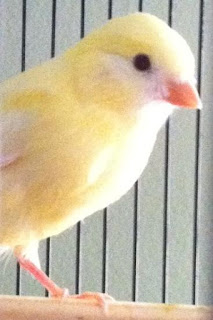Let's back up a few weeks:
When the chicks were just 14 days old, we took our annual week vacation at Cocoa Beach. You can't exactly leave chicks with a neighbor at this stage, and so they got a vacation too. I was delighted to meet Mega Bird Store owner Donna when I drove into town for some birdie supplies. I was already feeling overwhelmed feeding and cleaning up after three chicks and two doting parent canaries, as I knew this scenario would repeat itself in just a few short weeks; Canaries typically have two clutches a year. Donna asked me if I'd consider selling. Well, YES! First I needed to wait for the babies to mature, so I left with her business card.
Knowing I only wanted to own one canary, I went home and pondered which bird to keep. Keep the adult male, a proven singer? I would have loved to, but this was not a possibility, as he is a great daddy bird and feeds mommy bird while she nests, then feeds the chicks almost single-handedly (beakedly?) from about 1 week until they are weened at around 4 weeks old. Although the chicks were weened, Jo already laid a second clutch and I could not separate him from Jo and the current nest of 4 eggs (due to hatch around June 27th) and so I chose the yellowest of the three babies, Chick #2, chosen not only for his color, but also because he seems the most laid back and I need a little bird that will roll with the punches, handle the changes in locale and care takers, as I travel a lot. He will either ride along or will be left behind with family or friends.
 |
| Chick #2 - no name yet |
The deed is done, the birds are all gone but one and now I wait to see if this little yellow bird will sing as pretty as his father sings. This morning I played some YouTube canary songs (it's good training to give canaries something nice to imitate) and my lone bird listened intently, clung to the side of the cage and cheeped and chirped and strung a few notes. When I played his daddy canary's song, my lone birdie got very animated. It's a beginning, but nothing that would knock your socks off. Time will tell.


















